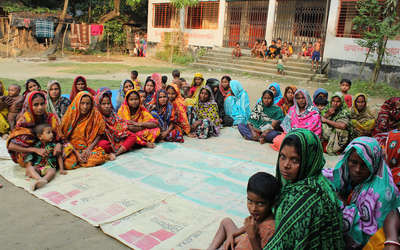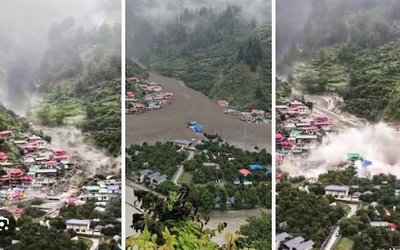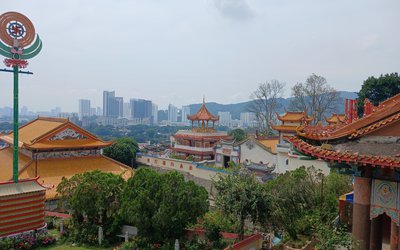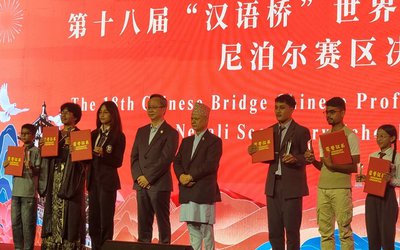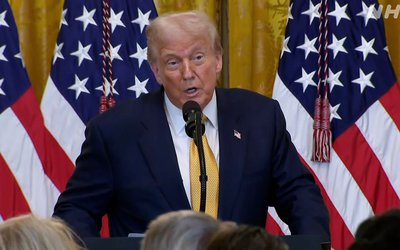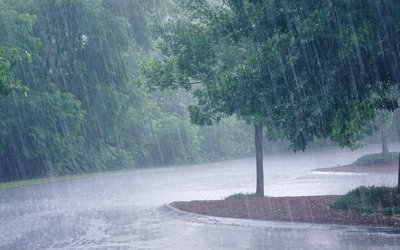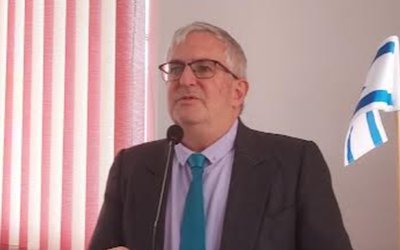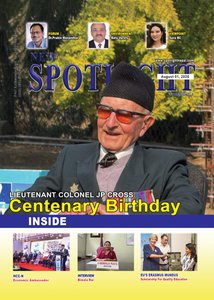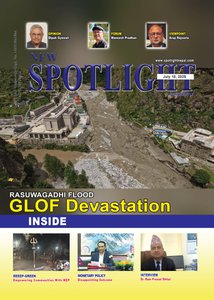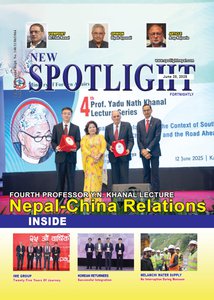Community Forestry is a success development model in Nepal. On the cornerstone of indigenous forest management system, the innovative idea for making it sustainable was visibly initiated from Banskharka, Pipaldanda, Thokarpa in 1973 ( 25th Shrwan, 2030BS) in Sindhupalchock district of Bagmati Province of Nepal, east of Kathmandu Valley. The government declared Thokarpa as origin of Community Forestry and recognized Dr. T.B.S. Mahat, forester, and N.P. Bhandari, locals, as initiators of the concept. In journey of community forestry, there are many more to be known to understand the present concept and practices in the field.
Based on the Ninth Forest Conference in 1974 organized by Ministry of Forests, the National Forestry Plan, 1976 set the Public Co-operation as one of the objectives of the plan "for the country's development and make people aware of, involved in , and partner to protect, produce and better utilize the country's forests". It further explored the concept to achieve the objective, public co-operation in addition to essential publicity for obtaining private, community or Panchayat level in protecting the forest through positive incentives such as reward, recognition or other types of encouragements. Eventually, the Forest Act, 1961 revised and included the forest management categories, Panchayat Forest and Panchayat Protected Forest which was legitimized through promulgating PF and PPF regulations in 1977. In person meeting with NP Bhandari in 2011, government forests in Thokarpa was handedover as PF and PPF to Thakarpa Panchayat in early 1978 based on the political boundary. The handover process was began in the country as well.
Kavre Palanchok District Forest Office was engaged in the pathway of the PF and PPF model of community Forestry prior to 1985. Natural forests were somehow protected by local peoples in the district. A hugh number of plantation forests were established in Kavre Palanchok districts. Mostly plantation forests were protected through government/project sponsored forest watchers in the early days.
As PF and PPF were handed-over to Panchayat, a lowest Unit of the Panchayat System of Government, some challenges were observed and put pressure to District Forest Offices for making it sustainable. Based on the context, some innovations were took placed in community forestry journey.
An initial attempt was made to improve local forest management in Tukucha Panchayat in Kavre Palchok District. Initially, DoF and Project staff engaged in a series of panchayat level public meetings. Based on the exercises, it was clear that there were number of assumptions at that time.
- there is a local community , i.e. a group of people with clear social boundaries capable of acting together cohesively
- the local community and local forest users were synonymous
- the forest users would come to a public meeting about forest management
- all the people who attended a meeting about forest management would speak openly and honestly at the meeting
- the meeting would be able to provide the information necessary for management plan formulation
- the forest committee formed at the meeting would be able to determine or understand its duties, authority and responsibility.
During the process, the team encountered the problems as a result of an inappropriate initial approach. Key issues were the meeting decided to manage the forest resources on a Panchayat and areas were allocated on wards basis and prices and harvesting times were fixed.
After resources data were collected, it was indicated that allocation of the forest resource at meeting might not be equitable, number of households were more than 500, which was too big. Further public level / panchayat level meeting did not arrange by forest committee and did not know its authority and duties as well.
After Panchayat level meeting, a series of ward level meetings held. It showed that views of real uses were not representative, such as forest usages, access rights, prices for forest products, and control of the forests. The team found that the Panchayat is not a local community capable for acting together for forest management. Again, we did ward level meetings for managing government owned natural broad-leaved forest in ward number 1. Further, two meetings were held in Pandey Gaon where male village leaders dominated the meetings. In addition, information were also not properly provided in the meetings. It was found that sub–panchayat level was not a local community.
A village centered and based on the maximum possible participation of all strata of village society showed promising results as a part of new approach in local forest management of Pandey Gaon Sano Ban. It was started with rapport building, identification of forests and users through focus group discussions, held interest group meetings, conflicts resolved through inter-village meetings on boundaries issues, prepare simple user group level forest management plan, election of forest user committee –inclusive. It was found that the new committee had been organizing meetings, protecting forests, organizing forest harvesting operations, gradually phased out of forest watchers provided by project, selected forest species preferences indicated by users for plantation on private and community forests.
Overall, clear cut boundary with user's identification made easy to run user group forestry – plantation, fire line construction, forest management prescriptions- with proper responsibility and sustainable benefit sharing process. The approach taken in Pandeygaon Sano Ban forest had been deeply studied by the legal and forestry experts from the Ministry of Forest and Soil Conservation and Ministry of Laws during the formulation of Master Plan for the Forestry Sector in 1988. The approach applied in Tukucha had become a foundation stone for the present day user group forestry in community forestry backup by the Master Plan for the Forestry Sector, 1989 and legitimized by Forest Act, 1993 and Forest Regulation 1995. At present, the Forest Act, 2019 and Forest Regulation, 2022 were also promulgated based on the former laws. As per Constitution of Nepal, 2015, Provincial governments have also promulgated Forest Acts and Regulation without deviating the concept of user group forestry applied in Tukucha as envisioned in the federal laws. As of 2025 July 16th, more than 25,06,490.70 hectares of national forests have been handed over to over 32,44,660 households through 23,090 community forests in Nepal.
Today, Community Forestry lies in the cross road. Key challenges to be resolved as soon as possible to overcome the issues. The government should plan for actions to make active executive committee and supply information, to revise operation plans and support for intensive forest management in sub watershed level, conduct orientation and capacity building program in favour of enterprises development and organize regular meeting and communications for coordination with local government.
User group forestry in Community forestry in Nepal has become an appropriate way of managing government forest in watershed boundary level. The decentralized forest policy and participatory approach for protection, promotion and silviculture based utilization of the forests and generating funds and spending the budget as per the decision of the forest user groups are major social binding and blending with technical aspects to make successful and popular user group forestry in the journey of community forestry in Nepal.
*Paudyal, Forester and can be reached at bijayarajpaudyal711@gmail.com
References
CFSC, 2025. CF Bulletin, Vol 21, Community Forestry Study Center, DoFSC
Gilmour, D.A. and King, G.C. 1990. Management of Forests for Local Use in the Hills of Nepal .1. Changing Forest Management Paradigms, Journal of World Forest Resource Management, 1990, Vol.4. pp 93-110
King, G.C; Hobley, M.; and Gilmour, D.A.. 1990. Management of Forests for Local Use in the Hills of Nepal .2. Towards the Development of Participatory Forest Management, Journal of World Forest Resource Management, 1990, Vol.5. pp 1-13
NAFP, 1982. Nepal's National Forestry Plan 1976(2033 BS), An unofficial English Translation and published by Nepal Australia Forestry Project, Technical Note 1/82.
Paudyal, B.R., King, G.C. and Malla, Y.B. 1987. The Development of Improved Local Forest Management in Kavre Palanchok District, Banko Janakari Vol. 1, No. 4, pp.16-19
Paudyal,Bijaya Raj. 2020. Community Forestry Journey in Nepal, https://www.spotlightnepal.com/2020/06/07/ community-forestry-journey-

Bijaya Raj Paudyal
Paudyal is General Secretary of Sinamangal Urban Service Society, Kathmandu Municipal-32
- Gene Conservation For Sustainable Future
- May 31, 2021
- Can Nepalese Foresters Revive Their Lost Agenda?
- Apr 12, 2021
- Fire The Uncontrolled Forest Fire
- Mar 29, 2021
- Nepal's Agenda : Simsar Conservation
- Jan 26, 2021
- Conservation Politics And Our Heroes
- Sep 23, 2020

